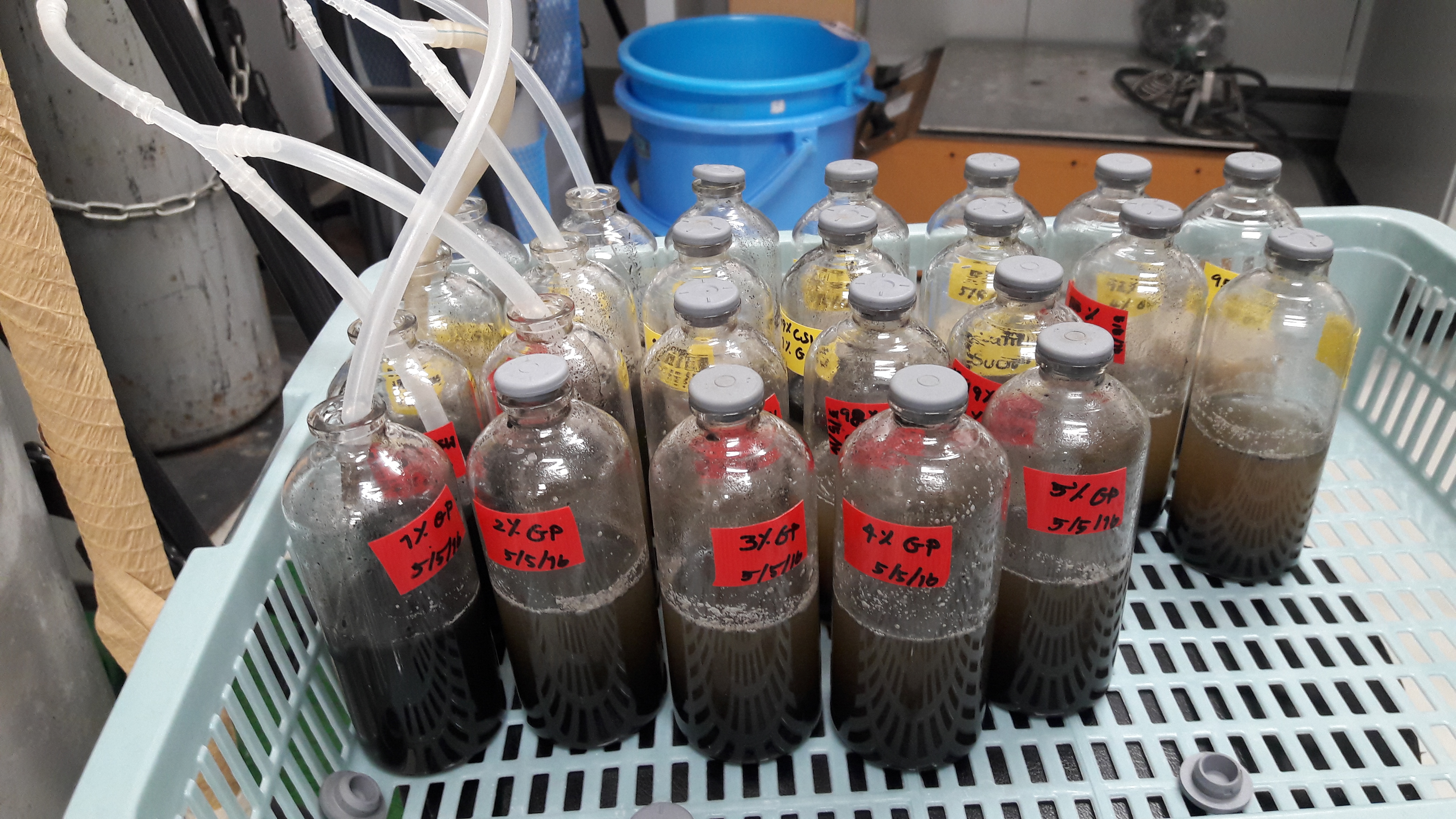Biogas and Biohythane Production from Anaerobic Co-digestion of Canned Sardine Wastewater with Glycerol Waste
Main Article Content
Abstract
A biochemical methane potential (BMP) test investigated the effect of glycerol waste (GW) concentration on anaerobic co-digestion with canned sardine wastewater (CSW). They were studied using the single-stage process at mesophilic (P1) and thermophilic (P2) conditions and two-stage mesophilic (P3) processes. The P3 process has provided the most significant potential for improving biogas production in the sardine canning industry. Using 4% GW (v/v), the optimal hydrogen and methane concentrations at P3 are 43.00 ml H2/g CODr and 303.69 ml CH4/g CODr, respectively. The P3 process was 11.33 m3 biohytane/m3 mixed substrate, and the biohytane composition contained 43.11% CH4, 21.45% H2, and 35.43% CO2. The modified Gompertz model could simulate satisfactory hydrogen and methane yields, corresponding to high regression coefficients (R2>0.90). Hydrogen-producing bacteria in the H2 batch reactor were dominated by Micrococcus sp. and Desulfovibrio sp., while Methanosaeta sp., Methanoculleus sp., and Methanosarcina sp. are the major methanogens in the CH4 batch reactor. A two-stage process of co-fermenting CSW and GW could be a potential option for simultaneous biofuel recovery and waste treatment.
Article Details

This work is licensed under a Creative Commons Attribution-NonCommercial-NoDerivatives 4.0 International License.
References
Intanoo, P.; Chaimongkol, P.; Chavadej, S. Hydrogen and methane production from cassava wastewater using two-stage up-flow anaerobic sludge blanket reactors (UASB) with an emphasis on maximum hydrogen production. Int J Hydrogen Energy. 2016, 41, 6107-6114. https://doi.org/10.1016/j.ijhydene.2015.10.125
Zhang, Q.; Hu, J.; Lee, D.J. Biogas from anaerobic digestion process: Research updates. Renew Energ, 2016, 98, 108-119. https://doi.org/10.1016/j.renene.2016.02.029
Ward. A.J.; Hobbs, P.J.; Holliman, P.J.; Jones, D.L. Optimisation of the anaerobic digestion of agricultural resources. Bioresour Technol. 2008, 99, 7928-7940. https://doi.org/10.1016/j.biortech.2008.02.044
Chowdhury, P.; Viraraghavan, T.; Srinivasan, A. Biological treatment processes for fish processing wastewater: A review. Bioresour Technol. 2010, 10, 439-449. https://doi.org/10.1016/j.biortech.2009.08.065
Pagliaccia, P.; Gallipoli, A.; Gianico, A.; Montecchio, D.; Braguglia, C.M. Single stage anaerobic bioconversion of food waste in mono and co-digestion with olive husks: Impact of thermal pretreatment on hydrogen and methane production. Int J Hydrogen Energy. 2016, 41, 905-915. https://doi.org/10.1016/j.ijhydene.2015.10.061
Da Silva, C.; AstalSiles, S.; Peces, M.; Campos, J.L.; Guerrero, L. Biochemical methane potential (BMP) test: reducing test time by early parameter estimation. Bioresour Technol. 2018, 71, 19-24. https://doi.org/10.1016/j.wasman.2017.10.009
Palenzuela-Rollon, A. Anaerobic digestion of fish processing wastewater with special emphasis on hydrolysis of suspended solids. London: Taylor and Francis, 1999.
Chen. Y.; Cheng, J.J.; Creamer, K.S. Inhibition of anaerobic digestion process: A review. Bioresour Technol. 2008, 99(10), 4044-4064. https://doi.org/10.1016/j.biortech.2007.01.057
Yenigun, O.; Demirel, B. Ammonia inhibition in anaerobic digestion: A review. Process Biochem. 2013, 48, 901-911. https://doi.org/10.1016/j.procbio.2013.04.012
Rivero, M.; Solera, R.; Perez, M. Anaerobic mesophilic co-digestion of sewage sludge with glycerol: Enhanced biohydrogen production. Int J Hydrogen Energy. 2014, 39, 2481-2488. https://doi.org/10.1016/j.ijhydene.2013.12.006
Vasquez, J.; Nakasaki, K. Effects of shock loading versus stepwise acclimation on microbial consortia during the anaerobic digestion of glycerol. Biomass and Bioenerg. 2016, 86, 129-135. https://doi.org/10.1016/j.biombioe.2016.02.001
Kalia, V.C.; Prakash, J.; Houl, S. Biorefinery for glycerol rich biodiesel industry waste. Indian J Microbiol. 2016, 53(2), 113-125. https://doi.org/10.1007/s12088-016-0583-7
O-Thong, S.; Hniman, A.; Prasertsan, P.; Imai, T. Biohydrogen production from cassava starch processing wastewater by thermophilic mixed cultures. Int J Hydrogen Energy. 2011, 36, 3409-3416. https://doi.org/10.1016/j.ijhydene.2010.12.053
Akyol, C.; Aydin, S.; Ince, O.; Ince, B. A comprehensive microbial insight into single-stage and two-stage anaerobic digestion of oxytetracycline-medicated cattle manure. Chem. Eng. J. 2016, 303, 675-684. https://doi.org/10.1016/j.cej.2016.06.006
Mamimin, C.; Singkhlala, A.; Kongjan, P.; Suraraksa, B.; Prasertsan, P.; Imai, T.; O-thong, S. Two-stage thermophilic fermentation and mesophilic methanogen process for biohydrogen production from palm oil mill effluent. Int J Hydrogen Energy. 2015, 40, 6319-6328. https://doi.org/10.1016/j.ijhydene.2015.03.068
Kafle, G.K.; Kim, S.H.; Sung, K.I. Ensiling of fish industry waste for biogas production: A lab-scale evaluation of biochemical methane potential (BMP) and kinetics. Bioresour Technol. 2013, 127, 326-336. https://doi.org/10.1016/j.biortech.2012.09.032
Konjan, P.; O-Thong, S.; Angelidaki, I. Performance and microbial community analysis of two-stage process with extreme thermophiliclic hydrogen and thermophilic methane production from hydrolysate in UASB reactors. Bioresour Technol. 2011, 102, 4028-4035. https://doi.org/10.1016/j.biortech.2010.12.009
Altschul, S.F.; Madden, T.L.; Schäffer, A.A.; Zhang, J.; Zhang, Z.; Miller, W.; David, J.; Lipman, D.J. Gapped BLAST and PSI-BLAST: a new generation of protein database search programs. Nucleic Acids Res. 1997, 25, 3389-3402. https://doi.org/10.1093/nar/25.17.3389
APHA. Standard methods for the examination of water and wastewater. 21th ed. Washington DC: USA, 2012.
Tian, H.L.; Duan, N.; Lin, C.; Li, X.; Zhong, M.Z. Anaerobic co-digestion of kitchen waste and pig manure with different mixing ratios. J Biosci Bioeng. 2015, 1205, 1-57. https://doi.org/10.1016/j.jbiosc.2014.11.017
Angelidaki, I.; Ellegaard, L. Co-digestion of manure and organic wastes in centralized biogas plants, status and future trends. Appl Biochem Biotech. 2003, 109, 95-105. https://doi.org/10.1385/ABAB:109:1-3:95
Switzenbaum, Michael, S.; Eugenio, G.G.; Robert, F.H. Monitoring of the anaerobic methane fermentation process. Enzyme and Microbial Technology. 1990, 12(10), 722-730. https://doi.org/10.1016/0141-0229(90)90142-D
Franke-Whittle, I.; Walter, A.; Ebner, C.; Insam, H. Investigation into the effect of high concentrations of volatile fatty acids in anaerobic digestion on mechanic communities. Waste Manage, 2014, 34, 2080-2089. https://doi.org/10.1016/j.wasman.2014.07.020
Sreethawong, T.; Chatsiriwatana, S.; Rangsuvijit, P.; Chavadej, S. Hydrogen production from cassava wastewater using anaerobic sequencing batch reactor: Effects of operational parameter, COD: N ratio, and organic acid composition. Int J Hydrogen Energy. 2010, 35, 4092-4102. https://doi.org/10.1016/j.ijhydene.2010.02.030
Luo, G.L.; Xie, L.; Zou, Z.; Zhou, Q.; Wang, J.Y. Fermentation hydrogen production from cassava stikkage by mixed anaerobic microflora: Effect of temperature and pH. Appl Energ. 2010, 87, 3710-3717. https://doi.org/10.1016/j.apenergy.2010.07.004
Khongkliang, P.; Kongjan, P.; O-Thong, S. Hydrogen and methane production from starch processing wastewater by thermophilic two-stage anaerobic digestion. Energ Procedia. 2015, 79, 827-832. https://doi.org/10.1016/j.egypro.2015.11.573


